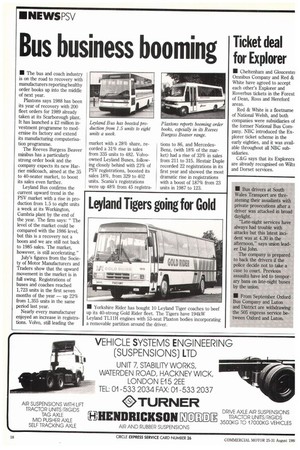Bus business booming
Page 16

If you've noticed an error in this article please click here to report it so we can fix it.
• The bus and coach industry is on the road to recovery with manufacturers reporting healthy order books up into the middle of next year.
Plaxtons says 1988 has been its year of recovery with 200 fleet orders for 1989 already taken at its Scarborough plant. It has launched a 22 million investment programme to modernise its factory and extend its manufacturing computerisation programme.
The Reeves Burgess Beaver minibus has a particularly strong order book and the company expects its new Harrier midicoach, aimed at the 35 to 40-seater market, to boost its sales even further.
Leyland Bus confirms the current upward trend in the PSV market with a rise in production from 1.5 to eight units a week at its Workington, Cumbria plant by the end of the year. The firm says: " The level of the market could be compared with the 1986 level, but this is a recovery not a boom and we are still not back to 1985 sales. The market, however, is still accelerating."
July's figures from the Society of Motor Manufacturers and Traders show that the upward movement in the market is in full swing. Registrations of buses and coaches reached 1,723 units in the first seven months of the year — up 22% from 1,355 units in the same period last year.
Nearly every manufacturer enjoyed an increase in registrations. Volvo, still leading the market with a 28% share, recorded a 31% rise in sales from 335 units to 482. Volvoowned Leyland Buses, following closely behind with 23% of PSV registrations, boosted its sales 18%, from 329 to 402 units. Scania's registrations were up 48% from 45 registra tions to 86, and MercedesBenz, (with 18% of the market) had a rise of 33% in sales from 211 to 315. Hestair Duple recorded 22 registrations in its first year and showed the most dramatic rise in registrations with a boost of 187% from 23 units in 1987 to 123.
























































